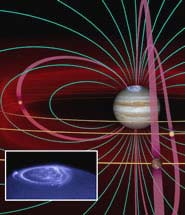Spacecraft rendezvous at Jupiter

Currents between Jupiter’s poles and three of its moons mark its auroras. <br>© NSAS/JPL <br>
Two space probes lift the lid on Jupiter’s magnetosphere.
Even Stanley Kubrick couldn’t have directed it better. In the first days of 2001, two spacecraft, Cassini and Galileo, met at Jupiter 400 million kilometres from Earth, to study the mysterious forces emanating from the giant planet.
The first analysis of the data they sent back has now been unveiled1-7. It paints a dramatic picture of the planet’s invisible magnetosphere – looping magnetic fields, crackling radio emissions and intense belts of radiation surround Jupiter and interact with the solar wind and the planet itself.
Consisting only of charged particles and magnetic field lines, magnetospheres are best studied close up. “You really need to be in it to measure what’s going on,” says Linda Spilker, deputy project scientist for the Cassini mission.
Cassini approached Jupiter from the direction of the incoming solar wind – the continuous blast of charged particles that stream out of the Sun. For the first time, the spacecraft recorded shifts in the wind while Galileo measured the responses of Jupiter’s magnetosphere.
Apparently, gusts of solar wind cause Jupiter’s magnetosphere to expand and contract like a giant balloon3. Simultaneous observations from the Hubble and Chandra space telescopes show that these compressions brighten the planet’s giant aurora. The aurora, which is like Earth’s northern and southern lights, dims as the pressure lessens1.
The probes also spotted electrons propelled by the planet’s magnetic field, whipping through Jupiter’s radiation belts at close to the speed of light2. Only a Jupiter-sized planet can generate magnetic fields strong enough to do this.
Astronomers will be reassured by the findings, for they agree with observations of Earth’s well-studied magnetosphere, which is routinely used to predict the behaviour of more distant planets.
Perhaps the most beautiful finding was of bright arcs of light traced through Jupiter’s aurora. The circling sprites arise when Jupiter’s moons, Io, Ganymede and Europa, emit giant tubes of charged particles. Jupiter’s magnetic fields suck these particles from the moons’ atmospheres down to the planet’s poles where they interact with one another, emitting an ethereal glow5.
Chance meeting
The cosmic conjunction wasn’t planned. Cassini was waltzing past Jupiter, using the giant’s gravitational energy to send it on to its final destination, Saturn. Galileo, an ageing probe that had been closely orbiting Jupiter and was thought to have stopped working, was found to be still going strong.
Planetary scientists “seized the opportunity offered by this first-ever conjunction of two spacecraft at an outer planet”, says Thomas Hill, of Rice University in Houston, Texas.
“There will be people looking at the data for many years,” says Spilker. Which is just as well. Another such rendezvous “would not be repeated for the foreseeable future”, says Cassini project scientist Dennis Matson.
The chance meeting was short-lived. Cassini has since flown on towards Saturn, due to arrive there in 2004. Galileo will make the ultimate sacrifice and descend into Jupiter’s atmosphere late next year.
References
- Gurnett, D. A. et al Control of Jupiter’s radio emission and aurorae by the solar wind. Nature, 415, 985 – 987, (2002).
- Bolton, S. J. et al Ultra-relativistic electrons in Jupiter’s radiation belts. Nature, 415, 987 – 991, (2002).
- Kurth, W. S. et al The dusk flank of Jupiter’s magnetosphere. Nature, 415, 991 – 994, (2002).
- Krimigis, S. M. et al A nebula of gases from Io surrounding Jupiter. Nature, 415, 994 – 996, (2002).
- Clarke, J. T. et al. Ultraviolet emissions from the magnetic footprints of Io, Ganymede and Europa on Jupiter. Nature, 415, 997 – 1000, (2002).
- Gladstone, G. R. et al.A pulsating auroral X-ray hot spot on Jupiter. Nature, 415, 1000 – 1003, (2002).
- Mauk, B. H. et al. Transient aurora on Jupiter from injections of magnetospheric electrons. Nature, 415, 1003 – 1005, (2002).
Media Contact
All latest news from the category: Physics and Astronomy
This area deals with the fundamental laws and building blocks of nature and how they interact, the properties and the behavior of matter, and research into space and time and their structures.
innovations-report provides in-depth reports and articles on subjects such as astrophysics, laser technologies, nuclear, quantum, particle and solid-state physics, nanotechnologies, planetary research and findings (Mars, Venus) and developments related to the Hubble Telescope.
Newest articles

First-of-its-kind study uses remote sensing to monitor plastic debris in rivers and lakes
Remote sensing creates a cost-effective solution to monitoring plastic pollution. A first-of-its-kind study from researchers at the University of Minnesota Twin Cities shows how remote sensing can help monitor and…

Laser-based artificial neuron mimics nerve cell functions at lightning speed
With a processing speed a billion times faster than nature, chip-based laser neuron could help advance AI tasks such as pattern recognition and sequence prediction. Researchers have developed a laser-based…

Optimising the processing of plastic waste
Just one look in the yellow bin reveals a colourful jumble of different types of plastic. However, the purer and more uniform plastic waste is, the easier it is to…


